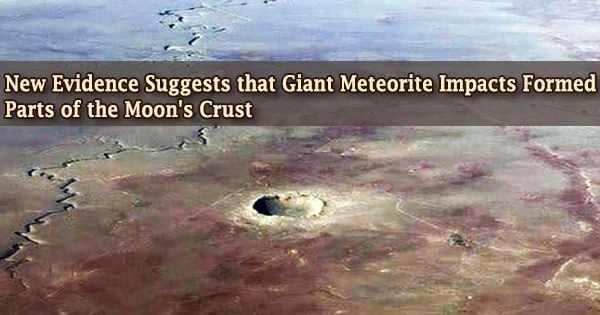A type of destructive event most commonly associated with disaster movies and dinosaur extinction may have also contributed to the formation of the Moon’s surface, according to new research published today in the journal Nature Astronomy.
The development of ancient rocks on the Moon may be directly connected to large-scale meteorite strikes, according to a group of international experts lead by the Royal Ontario Museum.
The lunar crust is mostly made up of oxygen, silicon, magnesium, iron, calcium, and aluminum, but it also contains crucial minor and trace elements including titanium, uranium, thorium, potassium, and hydrogen. The crust is considered to be roughly 50 km thick on average, based on geophysical studies.
The far-side crust is predicted to be around 15 kilometers thicker than the near-side crust. Only around the Apollo 12 and Apollo 14 landing sites has seismology been used to restrict the thickness of the crust.
NASA astronauts collected a rare rock during the Apollo 17 trip to the Moon in 1972, and the scientists conducted additional research on it. They discovered mineralogical evidence suggesting it developed at extremely high temperatures (in excess of 2300 °C/4300 °F), which can only be attained by melting a planet’s outer layer during a big impact event.
The researchers identified the presence of cubic zirconia, a mineral phase commonly used as a diamond alternative in jewelry, in the rock. The Moon has a very weak external magnetic field when compared to the Earth’s.
Rocks on Earth are constantly being recycled, but the Moon doesn’t exhibit plate tectonics or volcanism, allowing older rocks to be preserved. By studying the Moon, we can better understand the earliest history of our planet. If large, super-heated impacts were creating rocks on the Moon, the same process was probably happening here on Earth.
Dr. Lee White
Though it has already reverted to a more stable phase (the mineral known as baddeleyite), the crystal preserves distinct signs of a high-temperature structure.
Using the Virtual Microscope, you can see an interactive image of the complicated crystal utilized in the study. The researchers calculated the age of the grain while studying the structure of the crystal, revealing that baddeleyite formed approximately 4.3 billion years ago.
The high-temperature cubic zirconia phase was found to have developed before this time, implying that significant impacts were crucial in the formation of new rocks on the early Moon.
When the first samples from the Moon’s surface were returned fifty years ago, lunar scientists raised doubts regarding how lunar crustal rocks developed. Even today, an important topic remains unanswered: how did the Moon’s outer and inner layers mix after it formed?
Large impacts over 4 billion years ago may have caused this mixing, resulting in the varied spectrum of rocks visible on the Moon today, according to new research.
“Rocks on Earth are constantly being recycled, but the Moon doesn’t exhibit plate tectonics or volcanism, allowing older rocks to be preserved,” explains Dr. Lee White, Hatch Postdoctoral Fellow at the ROM.
“By studying the Moon, we can better understand the earliest history of our planet. If large, super-heated impacts were creating rocks on the Moon, the same process was probably happening here on Earth.”
“By first looking at this rock, I was amazed by how differently the minerals look compared to other Apollo 17 samples,” says Dr. Ana Cernok, Hatch Postdoctoral Fellow at the ROM and co-author of the study.
“Although smaller than a millimeter, the baddeleyite grain that caught our attention was the largest one I have ever seen in Apollo samples. This small grain is still holding the evidence for the formation of an impact basin that was hundreds of kilometers in diameter. This is significant because we do not see any evidence of these old impacts on Earth.”
The discoveries, according to Dr. James Darling, a reader at the University of Portsmouth and research co-author, “totally redefine scientists’ understanding of the samples acquired during the Apollo missions, and, in effect, the geology of the Moon.”
“These unimaginably violent meteorite impacts helped to build the lunar crust, not only destroy it,” he says.





